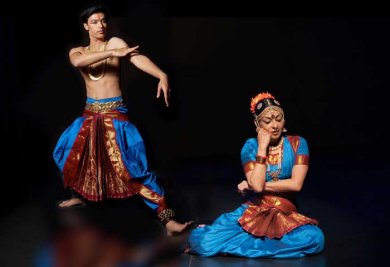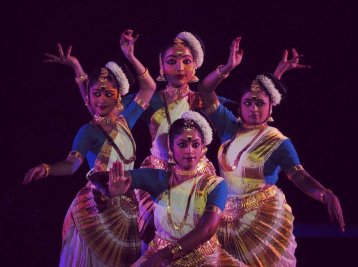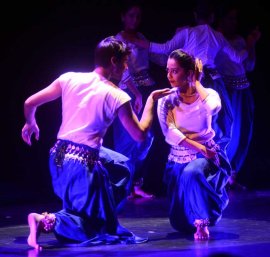
|   |

|   |
 e-mail: sunilkothari1933@gmail.com Stellar presentations at DIAF December 7, 2016 The Capital was agog with a series of dance performances of dancers within India and abroad, as Delhi International Arts Festival filled up the various venues with mind boggling variety of performing arts. The open air Meghdoot Theatre of Sangeet Natak Akademi was one of the venues for classical Indian dances. With a tree at the back of the stage and sky as the canopy with full moon and stars shooting in all directions, the dancers performing there created magic. From Ahmedabad, Mallika Sarabhai, daughter of the legendary dancer Mrinalini Sarabhai, and young and handsome Revanta, son of Mallika, performed together revealing the architectonic, beauty of Pandanallur School of Bharatanatyam. Looking gorgeous, belying her age, Mallika danced with verve, energy, stamina and astonishing command over the technique. There seemed a special chemistry between mother and son inspiring them to perform in unison. Revanta has evolved as a brilliant male Bharatanatyam dancer, with a commanding stage presence. His movements are strong, footwork perfect, laya sound and expressions eloquent. Opening with Ganesha kavutvam in praise of Lord Ganapati, with mnemonic syllables and description of the elephant headed God, destroyer of all evils, Revanta covered the space with ease under the tree. His dancing was joyous and lively. But it was in duet between Lord Shiva and Parvati which was in the nature of a competition between the Lord and his consort, that Revanta and Mallika displaying the spirit of competition, performed weaving intricate jathis and swaras, challenging each other, that they received spontaneous applause from the audience for their dexterous dancing. The mythological story revolves around how Lord Shiva lifted his leg, which out of sheer shyness Parvati did not, and lost the competition. In the song "Natiyinchu ni" set to Kamboji raga and adi tala, the poet describes their divine dance, where Lord Vishnu recited the jathis and Nandi played mridangam. It has become their favourite number invariably evoking joy. Mallika has been writing poems reflecting plight of women and raising relevant questions about why injustice has been meted out to them. Her poem in English is translated into Tamil and set to music by Kanniks Kannikeswaran in Ragamalika and adi tala. Presenting as a padam, Mallika questioned Lord Krishna, "Can love ever be wrong? In a world filled with hatred? A child loves his mother, mother loves her child, also loves parents. A lover loves his lover then how can it bring hate? When a woman loves a woman, she is treated with disdain and they are hounded. When she loves a man the world intervenes, asks of gotra, religion, colour of skin, who is their God; they are even stoned, beheaded, and then only world feels righteous. This is insane. O Krishna, when you were a mere boy and Radha a woman in her bloom, you loved each other and it is considered sacred love, then now why is there so much of hate? Teach us how to love again, when love was not used to slay. Let love win over hate, let love never be wrong." Her expressions of anguish were telling, resonating contemporary issues. Revanta and Mallika concluded with Swati Tirunal's scintillating tillana in Dhanashri raga and adi tala. With the text in Hindi "Dhun sunane ke naach rahi gori," the dance, the music, the sound of the ankle bells and of mridang all played in harmony. Their periya adavus, covering the stage, were impressive as they performed in perfect sync. The team of Darpana Academy's musicians, Jayan. K (vocal and nattuvangam), Palanivelu (mridangam), Manikandan (ghatam) and Annadurai (violin) gave them customary support.  Revanta and Mallika Sarabhai  Jayaprabha Menon's group The group choreography of Mohiniattam by Jayaprabha Menon looked ethereal. Bedecked in white Kerala saris with gold borders and typical side buns and golden ornaments the five dancers with leader Jayaprabha Menon showed how Mohiniattam has made strides in recent times. She is a senior disciple of Bharati Shivaji, and has established her International Academy of Mohiniattam in New Delhi. She chose to present Tattvam, for which script and music were by Kavalam Padmanabhan. Jayaprabha and group began with Malayalam translation of the Sanskrit shloka "Angikam bhuvanam yasya" in praise of Lord Shiva. She with her four disciples Sreelakshmi Namboodiri, Revathy Nair, Keerthana Vasavan and Radhika Menon created moving images of cosmic element, the universe as Shiva's body, the speech the entire literature, the stars and moon as his adornments and offered salutations to that cosmic God. The use of a separate raised platform on stage on which Jayaprabha stood in pose of Lord Shiva and the other dancers enacting various elements created striking visuals. Jayaprabha elaborated in Tattvam, the dynamic and the kinetic energy of the dance form through the depiction of Prakriti and Purusha, the male and female principles. What made the entire programme interesting was the Nagatattvam, inspired from Shri Narayana Guru's Kundalinipaattu in which Kundalini represented the dormant energy, with tantric connotations. It described the Ananda nritta of Lord Shiva. Serpent is an adornment of Shiva and its entwining on Lord Shiva's body as garland round his neck, earrings, ornaments at wrist, as ankle bells on his feet and surrounding his matted locks, Jayaprabha choreographed various serpentine movements in slow, undulating, graceful movements of Mohiniattam to Pantuvarali raga with mnemonics of paambe. Often, Jayaprabha stood in centre and dancers danced circling her, later standing behind her forming a series in ascending order, at times showing multi-arms of the lord, and at times holding various weapons, creating iconic images familiar to the audience. The journey of the soul was conveyed in symbolic manner as the dissolving duality of the temporal and the spatial. The rhythmic progression for ascending journey culminating in ecstatic union found a felicitous expression. It was striking group choreography in which the music was in keeping with the mood of Lord Shiva's dance. It was a visual treat! 

Crossing Oceans
Photos courtesy: Kaishiki Nrityabhasha
From Mumbai, Daksha Mashruwala, disciple of Guru Kelucharan Mohapatra, brought an unusual fare of three stories at Civil Service Organisation Institute (CSOI) on the final day of DIAF. Two performances clashed with the grand finale at The Nehru Park where a Russian troupe from Bolshoi ballet was performing. Therefore there was sparse audience for Crossing Oceans in which Greek, Australian Aboriginal and Japanese folklores were explored through Odissi, Chhau and Contemporary dance forms. Uttara Kennedy, Odissi dancer and daughter of Daksha Mashruwala, gave an excellent introduction to each presentation telling the stories. It helped the audience to follow the performance. The Greek mythological story in brief is as follows: As the ancient Greeks looked up at the night sky, they saw pictures in the stars. They saw bulls and scorpions, hunters and lions. One of the most well-known such constellations visible in the southern winter sky is that of Orion, the hunter. Daksha has choreographed this story with the dance of stars - twinkling away, shining, continually moving and changing. Orion, the great handsome hunter, born of Poseidon once lived on earth. He had the magical ability to walk on water, and he was prime huntsman for King Oenipion. He fell deeply in love with the king's daughter Merope, and one night when he was intoxicated after a feast, he made advances towards her. The king, enraged at his chief huntsman, rendered him blind. When Orion realized that he has lost his sight, he felt utterly helpless. He travelled east to Lemnos, with Kedallion sitting on his shoulders, guiding his path. As he felt the first rays of the rising sun in Lemnos, he recovered his sight and returned to his life as a hunter, taking Artemis, the beautiful goddess as his hunting partner. As the two hunters spent many happy days and nights together, Orion grew vain and one day boasted to Artemis that he would kill every beast upon this earth. So Mother Earth sent up a giant scorpion to kill Orion and stem his vanity. As the scorpion delivered the last fatal sting to Orion before himself dying, Artemis placed Orion amongst the stars, as a tribute to the friendship they once shared. The Earth placed scorpion then at the opposite end of the sky - one rising as the other sets, such that the two are never to be seen at the same time. This fascinating story set to technique of Odissi dance was well performed by Revanta Sarabhai as Orion, the arrogant huntsman. The music is imaginatively composed, not falling back upon Pallavi but in keeping with varying movements and moods of the story - a departure from traditional music but opening up new vistas. The simple costumes with only silver bangpatia, waist bands, and appropriate lighting created magic. The other Aboriginal Australian story has its origin in what is called the Dreamtime or the Dreaming. The Dreamtime is a place and time beyond the tangible, and is also often believed to be the time and space of when Creation occurred. The story of the Rainbow Serpent is perhaps according to Australians, the oldest creation belief of the world. The dance begins with a scene in the Australian wilderness. A group of aboriginals were out hunting for kangaroos. When the hunting party returned to their camp, they held a dance ceremony around the fire. Suddenly it rained and on the horizon they saw a beautiful multi-coloured arch - a rainbow. It was the mighty Rainbow Serpent. He told them that the whole earth was flat. There were no trees, no mountains, no water. No animals on earth and no birds in the sky. Nothing grew and nothing moved. Then one day, Gooriala, the Rainbow Serpent, awoke from his slumber and came out from under the ground. He started travelling across the land, from the South to the North in search of his tribe. As the serpent wound his way across the land, the movement of his body heaped up the mountains and dug troughs for the rivers. With each new thrust of his huge multi-coloured body, land was created. He was the biggest of the Dreamtime Beings. As he created clouds, it rained down on earth. With water, grass and trees sprang up. At last, tired with the effort of shaping the earth, he crawled into a waterhole to be cooled and soothed and then sank out of sight. Each time the animals visited a waterhole they were careful not to disturb the serpent for although they could not see him, they knew he was there. To this day, it is said that people can see the Rainbow Serpent from time to time as he travels across the sky from one waterhole to another. Daksha has choreographed the suggestive movements of dance of aboriginals with Mayurbhanj Chhau and serpentine movements, at times extremely slow, to the sound of aboriginal Australian instrument Didgeridoo with effect, simple gestures for trees, grass, water and pointing at sky, the arch of rainbow. One indeed experienced different feelings evoked for such a theme and the group of dancers executed the movements with skill. The 10th century Japanese folktale story deals with the tale of the moon princess, describing the love and life of the mysterious princess Kaguya. A woodcutter, a simple man, makes a meagre living cutting bamboo. One day he chances upon a beautiful baby girl inside a bamboo stalk. He brings her home to his wife, much to the curiosity of the villagers. As the girls grows, the whole village slowly falls in love with the beautiful Kaguya. Their curiosity turns into endearment. As she comes of age the news of her beauty reaches to the Grand Emperor of Japan. He comes to ask her hand in marriage. Kaguya loves the Emperor too, but in her heart, there is a longing so persistent that there is no room for anyone or anything else. Her heart longs to go back to the moon, her place of origin, where she could truly be free and boundless. The princess is torn between these two emotions of freedom and attachment. There is love from the Emperor, yet this love stifles and binds her. And so, on a full moon night, leaving behind a heart broken village in her wake, Kaguya leaves for the moon. It is a journey signifying perhaps the final journey that all of humankind may choose to make one day, leaving behind worldly attachments and journeying onward to a plane of higher spiritual existence. Choreographed by Singapore based Odissi and Contemporary dance exponent Raka Maitra, there is a distinct Japanese feel, so consummately evoked and performed by the dancers in slow motion, even the duet between Namrata as Princess and Revanta as Emperor is delicate, and the finale with the path of moon beams suggested by a silk cloth piece unfolded has an exquisite visual appeal, with soul stirring music, the lighting by Debiprasad Mishra creating the right ambience. These three stories presented in a 70-minute duration reveal Daksha's and Raka's deep understanding of forms and an ability to metamorphose them in stunning visuals and unusual soundscape by sitarist Hindol Deb. There was admirable synchronization with the music and the dance and noticeable absence of ornamentation. The minimalistic lines of the movements epitomised understated eloquence. A memorable experience.  Dr. Sunil Kothari is a dance historian, scholar, author and critic. He is honored with Padma Shri, Sangeet Natak Akademi award and Senior Critic Award from Dance Critics Association, NYC. Post your comments Please provide your name and email id when you use the Anonymous profile in the blog to post a comment. All appropriate comments posted with name & email id in the blog will also be featured in the site. |